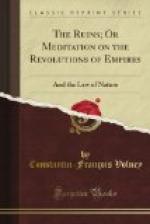“Such was the legislator of the Hebrews; who, wishing to separate his nation from all others, and to form a distinct and solitary empire, conceived the design of establishing its basis on religious prejudices, and of raising around it a sacred rampart of opinions and of rites. But in vain did he prescribe the worship of the symbols which prevailed in lower Egypt and in Phoenicia;* for his god was nevertheless an Egyptian god, invented by those priests of whom Moses had been the disciple; and Yahouh,** betrayed by its very name, essence (of beings), and by its symbol, the burning bush, is only the soul of the world, the moving principle which the Greeks soon after adopted under the same denomination in their you-piter, regenerating being, and under that of Ei, existence,*** which the Thebans consecrated by the name of Kneph, which Sais worshipped under the emblem of Isis veiled, with this inscription: I am al that has been, all that is, and all that is to come, and no mortal has raised my veil; which Pythagoras honored under the name of Vesta, and which the stoic philosophy defined precisely by calling it the principle of fire. In vain did Moses wish to blot from his religion every thing which had relation to the stars; many traits call them to mind in spite of all he has done. The seven planetary luminaries of the great candlestick; the twelve stones, or signs in the Urim of the high priests; the feast of the two equinoxes, (entrances and gates of the two hemispheres); the ceremony of the lamb, (the celestial ram then in his fifteenth degree); lastly, the name even of Osiris preserved in his song,**** and the ark, or coffer, an imitation of the tomb in which that God was laid, all remain as so many witnesses of the filiation of his ideas, and of their extraction from the common source.
* “At a certain period,” says Plutarch (de Iside) “all the Egyptians have their animal gods painted. The Thebans are the only people who do not employ painters, because they worship a god whose form comes not under the senses, and cannot be represented.” And this is the god whom Moses, educated at Heliopolis, adopted; but the idea was not of his invention.
** Such is the true pronunciation of the Jehovah of the moderns, who violate, in this respect, every rule of criticism; since it is evident that the ancients, particularly the eastern Syrians and Phoenicians, were acquainted neither with the J nor the P which are of Tartar origin. The subsisting usage of the Arabs, which we have re-established here, is confirmed by Diodorus, who calls the god of Moses Iaw, (lib. 1), and Iaw and Yahouh are manifestly the same word: the identity continues in that of You-piter; but in order to render it more complete, we shall demonstrate the signification to be the same.
In Hebrew, that is to say, in one of the dialects of the common language of lower Asia, Yahouh is the participle of the verb hih,




